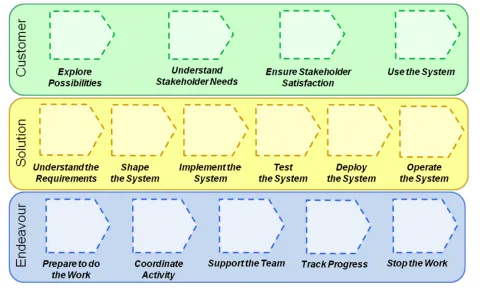Detailed Descriptions of the Activity Spaces
The OMG Essence Standard describes Activity Spaces in three levels of detail:
- The Name (as in the picture adjacent)
- Brief Description, including Entry and Completion Criteria (as shown on the cards)
- Detailed Description (included in the following section and illustrated in the example above)
Customer Activity Spaces
The customer area of concern contains four activity spaces that cover the discovery of the opportunity and the involvement of the stakeholders.
Explore Possibilities
Explore the possibilities presented by the creation of a new or improved software system. This includes the analysis of the opportunity to be addressed and the identification of the stakeholders. Explore possibilities to:
• Enable the right stakeholders to be involved.
• Understand the stakeholders’ needs.
• Identify opportunities for the use of the software system.
• Understand why the software system is needed.
• Establish the value offered by the software system.
Input: None
Entry Criteria: None
Completion Criteria: Stakeholders::Recognized, Opportunity::Value Established.
Understand Stakeholder Needs
Engage with the stakeholders to understand their needs and ensure that the right results are produced. This includes identifying and working with the stakeholder representatives to progress the opportunity.
Understand stakeholder needs to:
• Ensure the right solution is created.
• Align expectations.
• Collect feedback and generate input.
• Ensure that the solution produced provides benefit to the stakeholders.
Input: Stakeholders, Opportunity, Requirements, Software System
Entry Criteria: Stakeholders::Recognized, Opportunity::Value Established
Completion Criteria: Stakeholders::In Agreement, Opportunity::Viable
Ensure Stakeholder Satisfaction
Share the results of the development work with the stakeholders to gain their acceptance of the system produced and verify that the opportunity has been successfully addressed.
Ensure the satisfaction of the stakeholders to:
• Get approval for the deployment of the system.
• Validate that the system is of benefit to the stakeholders.
• Validate that the system is acceptable to the stakeholders.
• Independently verify that the system delivered is the one required.
• Confirm the expected benefit that the system will provide.
Input: Stakeholders, Opportunity, Requirements, Software System
Entry Criteria: Stakeholders::In Agreement, Opportunity::Value Established
Completion Criteria: Stakeholders::Satisfied for Deployment, Opportunity::Addressed
Use the System
Observe the use the system in an operational environment and how it benefits the stakeholders.
Use the system to:
• Generate measurable benefits.
• Gather feedback from the use of the system.
• Confirm that the system meets the expectations of the stakeholders.
• Establish the return-on-investment for the system.
Input: Stakeholders, Opportunity, Requirements, Software System
Entry Criteria: Stakeholders::Satisfied for Deployment, Opportunity::Addressed
Completion Criteria: Stakeholders::Satisfied in Use, Opportunity::Benefit Accrued
Solution Activity Spaces
The solution area of concern contains six activity spaces that cover the capturing of the requirements and the development of the software system.
Understand the Requirements
Establish a shared understanding of what the system to be produced must do.
Understand the requirements to:
• Scope the system.
• Understand how the system will generate value.
• Agree on what the system will do.
• Identify specific ways of using and testing the system.
• Drive the development of the system.
Input: Stakeholders, Opportunity, Requirements, Software System, Work, Way-of-Working
Entry Criteria: None
Completion Criteria: Requirements::Coherent
Shape the System
Shape the system so that it is easy to develop, change and maintain, and can cope with current and expected future demands. This includes the overall design and architecting of the system to be produced.
Shape the system to:
• Structure the system and identify the key system elements.
• Assign requirements to elements of the system.
• Ensure that the architecture is suitably robust and flexible.
Input: Stakeholders, Opportunity, Requirements, Software System, Work, Way-of-Working
Entry Criteria: Requirements::Coherent
Completion Criteria: Requirements::Acceptable, Software System::Architecture Selected
Implement the System
Build a system by implementing, testing, and integrating one or more system elements. This includes bug fixing and unit testing.
Implement the system to:
• Create a working system.
• Develop, integrate, and test the system elements.
• Increase the number of requirements implemented.
• Fix defects.
• Improve the system
Input: Requirements, Software System, Way-of-Working
Entry Criteria: Software System::Architecture Selected
Completion Criteria: Software System::Ready
Test the System
Verify that the system produced meets the stakeholders’ requirements.
Test the system to:
• Verify that the software system matches the requirements
• Identify any defects in the software system.
Input: Requirements, Software System, Way-of-Working
Entry Criteria: Requirements::Acceptable, Software System::Architecture Selected
Completion Criteria: Requirements::Fulfilled, Software System::Ready
Deploy the System
Take the tested system and make it available for use outside the development team.
Deploy the system to:
• Package the software system up for delivery to the live environment.
• Make the software system operational.
Input: Stakeholders, Software System, Way-of-Working
Entry Criteria: Software System::Ready
Completion Criteria: Software System::Operational
Operate the System
Support the use of the software system in the live environment.
Operate the system to:
• Maintain service levels.
• Support the stakeholders who use the system.
• Support the stakeholders who deploy, operate, and help support the system.
Input: Stakeholders, Opportunity, Requirements, Software System, Way-of-Working
Entry Criteria: Software System::Ready
Completion Criteria: Software System::Retired
Endeavor Activity Spaces
The endeavor area of concern contains five activity spaces that cover the formation and support of the team, and planning and co-coordinating the work in-line with the way of working.
Prepare to do the Work
Set up the team and its working environment. Understand and commit to completing the work.
Prepare to do the work to:
• Put the initial plans in place.
• Establish the initial way of working.
• Assemble and motivate the initial project team.
• Secure funding and resources.
Input: Stakeholders, Opportunity, Requirements
Entry Criteria: None
Completion Criteria: Team::Seeded, Way of Working::Foundation Established, Work::Prepared
Coordinate Activity
Co-ordinate and direct the team’s work. This includes all ongoing planning and re-planning of the work, and adding any additional resources needed to complete the formation of the team.
Coordinate activity to:
• Select and prioritize work.
• Adapt plans to reflect results.
• Get the right people on the team.
• Ensure that objectives are met.
• Handle change.
Input: Requirements, Team, Work, Way of Working
Entry Criteria: Team::Seeded, Work::Prepared
Completion Criteria: Team::Formed, Work::Under Control
Support the Team
Help the team members to help themselves, collaborate, and improve their way of working.
Support the team to:
• Improve team working.
• Overcome any obstacles.
• Improve ways of working.
Input: Team, Work, Way of Working
Entry Criteria: Team::Formed, Way of Working::Foundation Established
Completion Criteria: Team::Collaborating, Way of Working::In Place
Track Progress
Measure and assess the progress made by the team.
Track progress to:
• Evaluate the results of work done.
• Measure progress.
• Identify impediments.
Input: Requirements, Team, Work, Way of Working
Entry Criteria: Team::Collaborating, Way of Working::In Place, Work::Started
Completion Criteria: Team::Performing, Way of Working::Working Well, Work::Concluded
Stop the Work
Shutdown the software engineering endeavor and hand over the team’s responsibilities.
Stop the work to:
• Close the work.
• Hand over any outstanding responsibilities
• Hand over any outstanding work items.
• Stand down the team.
• Archive all work done.
Input: Requirements, Team, Work, Way of Working
Entry Criteria: Team::Performing, Way of Working::Working Well, Work::Concluded
Completion Criteria: Team::Adjourned, Way of Working::Retired, Work::Closed
Getting Started
To get started, download the Activity Space Cards and get some ideas on how to use them in this article. You may also find the Alpha State Cards useful to help you understand the states that the Activity Spaces relate to. You can download those via the same link.
Main Image Credit: Photo by Faisal Waheed on Unsplash

